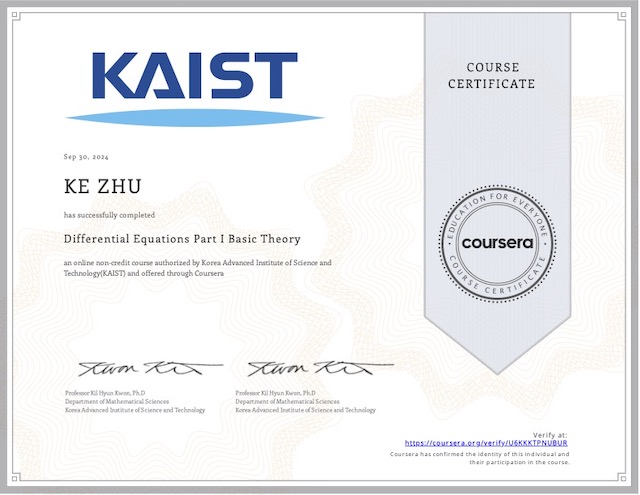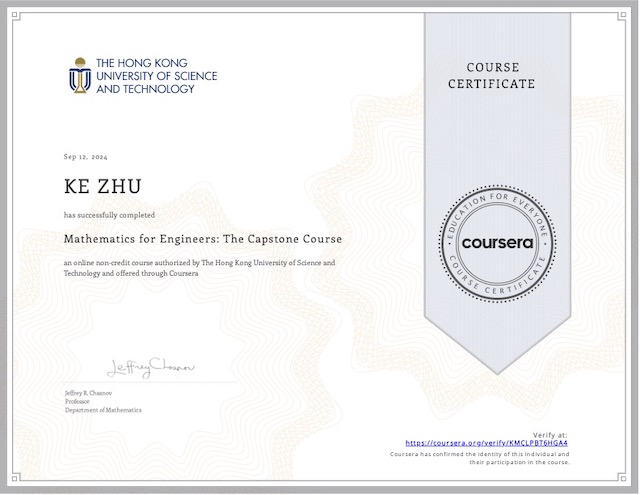Matrix is a rectangular array of numbers. In an m*n matrix, m stands for the number of rows, n stands for the number of columns. When m or n equals to 1, we have row vectors or column vectors, respectively.
Addition and Multiplication
Adding two matrices (with the same size) is just adding each of the components. Multiplication of a Matrix by scale k is just k get multiplied by each of the elements. Multiplication of matrices is a little special, we went across the columns of the first matrix and down the rows of the second matrix. So the second matrix must has the same number of rows as the first matrix has columns.
(m * n)(n * p) -> (m * p)Elements in the resulting matrix is derived from corresponding row and column in multiplicands. It is important that they don’t commute under multiplication.
C = A B
cij = Σk (aik × bkj)
A (B C) = (A B) C
A B = A C does not imply B = C
A B ≠ B AThere are a few special matrices, which are very useful:
- Zero matrix: 0. There will be many times you need to solve equation like A * x = 0.
- Identity matrix: I. This is always a square matrix and it commutes, like A * I = I * A = A
- Diagonal matrix: This only has elements on diagonal and zeros everywhere else.
- Banded matrix: For example: tri-diagonal matrix.
- Upper / Lower triangular matrix: there are only elements above or below the diagonal.
Transpose
Taking the transpose of a matrix is to make the rows of the matrix become the columns, and the columns become the rows: aTij = aji. Here are some algebra of the transpose:
(AT)T = A
(A + B)T = AT + BT
(A B)T = BT ATMatrix A is symmetric if AT = A. It is a skew-symmetric matrix if AT = -A. When a matrix is symmetric, you actually reduce the number of freedom that you have in the matrix. Any square matrix can be written as the sum of a symmetric and skew-symmetric matrix. ATA is symmetric.
Inner product / Dot product (of two vectors)
Suppose 2 column vectors u and v, their inner product is uT v which gives a scalar. If uT v = 0, then u and v are orthogonal (perpendicular) to each other. The norm of vector u is ||u||, which is the length of the vector. The vector u is normalized if ||u|| = 1.
||u|| = (uTu)1/2 = (u12 + u22 + ... Un2)1/2If two vectors are orthogonal to each other and normalized, then both vectors are orthonormal.
Outer product
The outer product of 2 vectors u and v are uvT.
Inverse
Not all matrices are invertible. If determinant of a matrix is zero, then 1 / determinant does not exist, so the inverse of this matrix does not exist. If a square matrix A is invertible then A A-1 = I = A-1 A. Its inverse is unique.
(A B)-1 = B-1 A-1
(AT)-1 = (A-1)TOrthogonal matrices
The inverse of an orthogonal matrix is equal to the transpose of the matrix: Q-1 = QT , i.e.: Q QT = QT Q = I, which is actually multiplying a row of Q against a row of Q. So if the rows are the same, you get 1; if the rows are different, you get zero. This is the definition of orthonormality.
(Q x)T (Q x) = ||Q x||2 = xT QT Q x = xT I x = ||x||2The equation above tells us the orthogonal matrix preserves norms or length. The rotation of a vector through an angle can be done by an orthogonal matrix. The rotation matrix Rθ is an orthogonal matrix because the length of vector x does not change when you rotate it.
Rθ x = x'Solving the equation, we get that Rθ is below, and more R(-θ) = R(θ)-1.
cosθ -sinθ
sinθ cosθA permutation matrix is an n-by-n matrix which when you multiply it against another matrix, you permute the rows of the matrix. Identity matrix is also called permutation matrix which keeps the same order. Below is an example of 2-by-2 permutation matrix:
0 1
1 0When multiplied on the left, it permutes the rows of a matrix; when multiplied on the left, it permutes the columns of a matrix. Actually permutation matrix is just the identity matrix with its rows permuted.
Gaussian Elimination
The main reason for matrices is to represent linear systems of equations. The first step is to form “Augmented matrix”. Next we do some operations on the augmented matrix to make the system of linear equations easier to solve. We can change the order of equations (i.e. the order of the rows of the matrix). We can multiply an equation (a row of the matrix) by a constant. We can also multiply an equation with a constant and then add it to another equation. So we can bring the matrix to the upper triangular form, which is the goal of Gaussian Elimination. After that you could use back-substitution to calculate values for all variables.
Reduced Row Echelon Form
We go even further than upper triangular form, we go all the way to possibly the identity matrix. The idea is you use the pivots to eliminate not just below the pivot, but also above the pivot. Columns with pivots are called pivot column, other columns are called non-pivot columns. In those pivot columns, all its pivots are 1s, all other elements are 0s.
Computing Inverse
If a matrix A has an inverse, then A A-1 = I. You can see this as A multiplies i-th column of A-1 and get the i-th column of I. So to solve what A-1 is, we just need to solve n equations in this form:
A ai-1 = ei-1The augmented matrix will look like A with I attached to the right, i.e. AI, we bring the matrix A to reduced row echelon form, then the I part of the augmented matrix will become A inverse.
AI --> bring A to reduced row echelon form --> IA-1 LU decomposition
It actually turns out the Gaussian elimination procedure gives us a matrix decomposition. We can write A = L U, where L is a lower triangular matrix, and U is an upper triangular matrix. This is called LU decomposition of A.
An elementary matrix is an identity matrix with one of zeros replaced by a number. The Gaussian elimination of matrix A is actually equivalent to an elementary matrix multiplying the matrix A.
Gaussian elimination U = Mn ... M3 M2 M1 A
where Mi are elementary matrices, U is upper triangular matrixAll of Mi matrices are invertible, we could get
M1-1 ... Mn-2-1 Mn-1-1 Mn-1 U = A
where Mi-1 can be easily calculated: the non-diagonal elements multiplied by -1Mn-1 … M3-1 M2-1 M1-1 is actually a lower triangular matrix, called L. So finally we got A = L U, which is called LU decomposition. The value of LU decomposition is when you solve A x = b, and there are many b‘s. Then if you first find A = L U, then use L U x = b to solve, it will be very fast.
My Certificate
For more on Matrices & Systems of Linear Equations, please refer to the wonderful course here https://www.coursera.org/learn/matrix-algebra-engineers
Related Quick Recap
I am Kesler Zhu, thank you for visiting my website. Check out more course reviews at https://KZHU.ai



